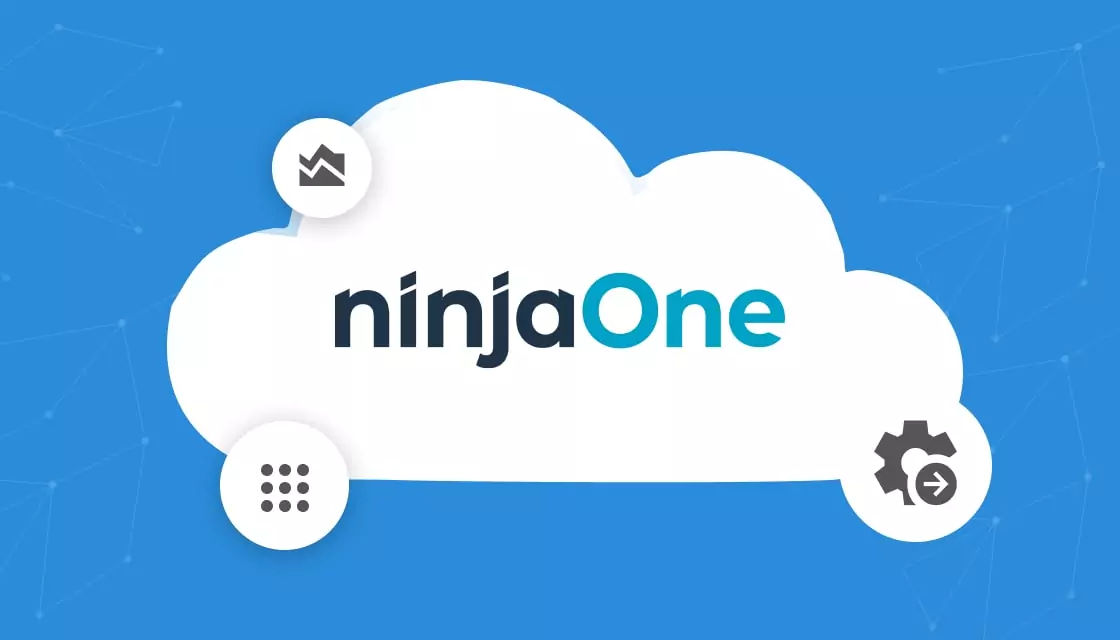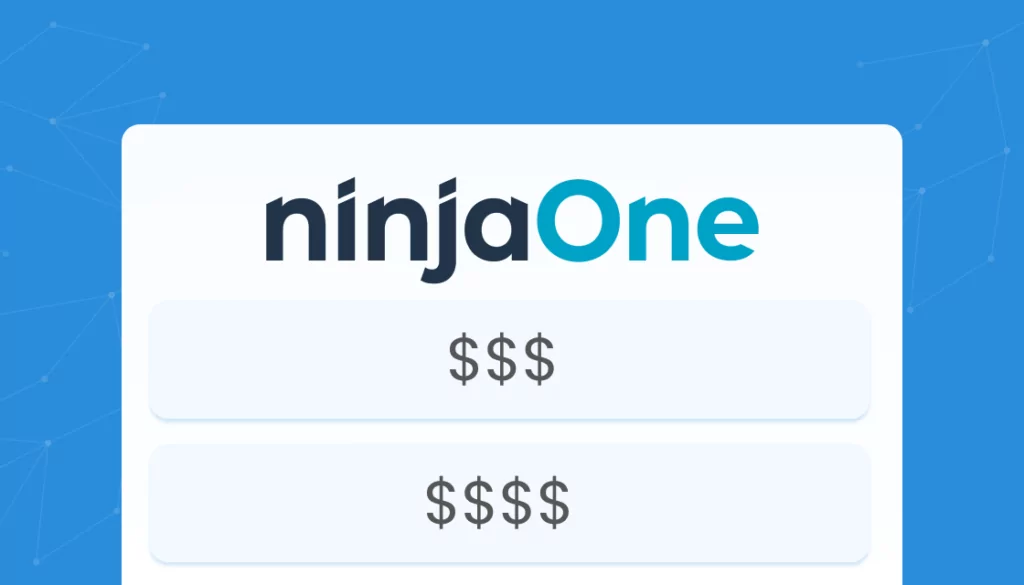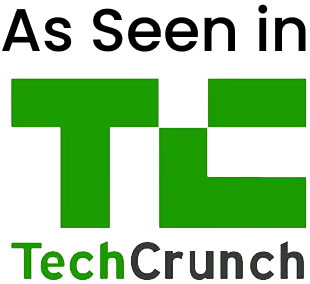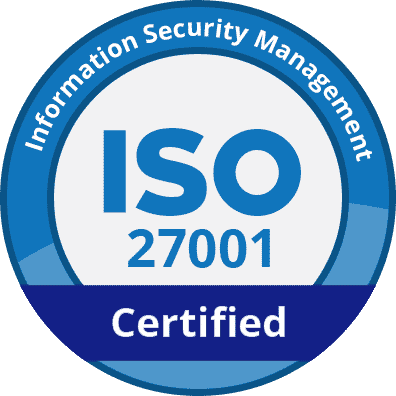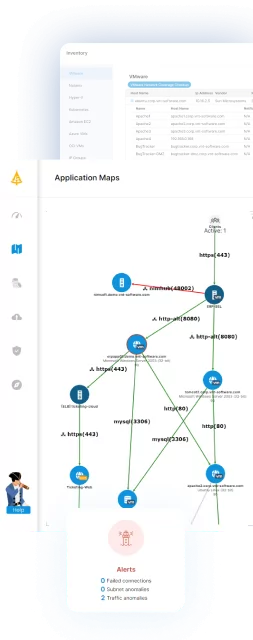What Is NinjaOne?
NinjaOne is a cloud-based IT management platform designed to help managed service providers (MSPs) and IT teams streamline endpoint monitoring, patch management, remote access, and IT automation. Formerly known as NinjaRMM, the platform offers tools for managing Windows, macOS, and Linux devices, allowing organizations to improve IT efficiency while reducing downtime and security risks.
The platform integrates features like automated patch deployment, remote control, alerting, and asset inventory management, consolidating IT management under a single interface. However, some notable limitations, such as restricted scripting options and limited SSO flexibility, have led users to explore alternative platforms.
Table of Contents
ToggleWhy Consider Alternatives to NinjaOne? Common Limitations of NinjaOne
The NinjaOne IT management platform has some limitations that might lead users to consider alternatives. These limitations were reported by users on the G2 platform:
- Limited mobile app functionality: While the mobile app allows for remote access, it lacks some features and could be more user-friendly.
- Challenges with offline equipment: Adding offline devices is not as seamless as it could be, though improvements have been made over time.
- Complex organizational management: The platform’s structure for managing organizations could be more intuitive and simpler.
- Lack of native Linux remote access: NinjaOne primarily supports Windows for remote desktop access. Linux users must rely on workarounds like Wine or virtual machines.
- Steep learning curve: Some users find the interface clunky and overwhelming, especially when first getting started.
- Basic scripting capabilities: The scripting functionality is limited, lacking features like encrypted saved parameters or optional parameter support.
- Restricted SSO integration: Currently, NinjaOne integrates only with Microsoft Entra for single sign-on (SSO), limiting flexibility for organizations using other identity providers.
- Limited API and GitHub integration: Users have requested better API access for managing policies and custom scripts, as well as direct Git/GitHub integration.
- No native macOS Apple silicon or Windows on ARM support: While the agent runs under interpreters, native binaries for these architectures are still missing.
- CVE scanning gaps: The platform does not always catch all common vulnerabilities and exposures (CVEs), which could leave security risks undetected.
Related content: Read our guide to NinjaOne pricing (coming soon)
Notable NinjaOne Alternatives and Competitors
1. Faddom
Faddom is an agentless, real-time application dependency mapping platform designed to provide IT teams with full visibility into their infrastructure. With a fast deployment time of under 60 minutes, it offers seamless scalability for both on-premise and cloud environments. Its passive, non-intrusive approach ensures minimal network impact, making it an ideal solution for complex IT ecosystems.
Key features of Faddom:
- Agentless application mapping: Automatically detects and visualizes dependencies without requiring agents.
- Scalability: Adapts to organizations of any size, from small IT teams to large enterprises.
- Security-focused design: Operates without active network scanning, reducing security risks.
- Hybrid environment support: Maps dependencies across on-premise, cloud, and hybrid infrastructures.
- Change impact analysis: Helps IT teams assess the risks of infrastructure modifications before implementation.
Learn more about Faddom for application mapping or start a free trial!
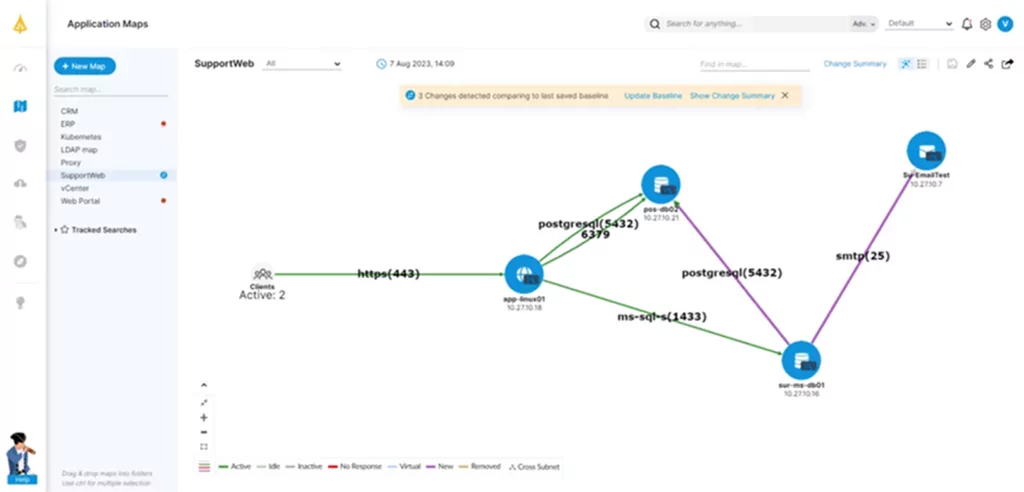
2. Atera
Atera is a remote monitoring and management (RMM) platform that helps IT professionals simplify operations, automate tasks, and gain visibility into IT environments. It provides real-time monitoring, automated patch management, integrated remote access, and reporting capabilities.
Key features include:
- Real-time monitoring and alerts: Tracks system activity, network performance, and device health, with automated alerts for issue resolution.
- IT automation: Supports automation of repetitive tasks, including system cleanup, software updates, and onboarding processes using scripts and threshold-based actions.
- Patch management: Manages OS updates for Windows and Mac, with integration for Chocolatey and Homebrew to automate third-party software patching.
- Server monitoring: Provides real-time tracking of server health, proactive alerts, and automated remediation to prevent downtime.
- Reporting and analytics: Offers system health reports, inventory audits, and licensing insights to track IT performance and demonstrate business value.
Source: Atera
3. Kaseya VSA
Kaseya VSA is an RMM platform that provides IT teams with visibility and control over their endpoints. It enables automated patch management, security enforcement, and backup solutions, ensuring IT environments remain secure. Kaseya VSA supports a range of devices, including PCs, Macs, virtual desktops, mobile devices, and IoT endpoints.
Key features include:
- Endpoint management: Supports management of various endpoint types, from traditional workstations to mobile devices and IoT.
- Automated patch management: Ensures security by automatically patching endpoints, with access to a software catalog.
- Security hardening and threat protection: Implements policy-based configuration security and integrates with AV, AM, EDR, and managed SOC for improved threat detection.
- RMM automation: Automates ticketing, network monitoring, patching, security, and backup, reducing operational overhead and improving service delivery.
- Microsoft 365 management: Provides a built-in module for managing M365 tenants, simplifying user onboarding, offboarding, and security hardening.
Source: Kaseya
4. N-sight RMM
N-able N-sight RMM is a unified IT management platform for remote monitoring, patch management, automation, and security. It provides IT teams with visibility across physical, hybrid, and cloud environments for endpoint management. The platform includes built-in ticketing, billing, and remote access capabilities.
Key features include:
- Remote management: Monitors and manages Windows, macOS, Linux, and mobile devices with alerts and automated patching.
- Patch management: Ensures compliance and security by automating updates for operating systems and third-party applications.
- Flexible automation: Provides low-code and no-code automation with 650+ prebuilt scripts and drag-and-drop policy management.
- Apple device management: Integrates with Apple Business Manager for automated deployment and policy enforcement on iOS, iPadOS, and macOS.
- Secure remote access: Supports attended and unattended sessions with encrypted connections, file transfer, and live chat.
Source: N-able
5. Action1
Action1 is a cloud-native endpoint management and patching platform that automates vulnerability remediation across Windows and macOS environments. It provides visibility into missing updates, ensures continuous compliance, and eliminates the need for VPNs or on-premises infrastructure.
Key features include:
- Third-party patching: Automates patching for a range of third-party applications, ensuring patch coverage for offline endpoints.
- Cross-OS patching: Updates Windows and macOS devices regardless of their network status or domain membership.
- Vulnerability management: Detects and remediates security vulnerabilities to prevent breaches and ransomware attacks.
- Enterprise-grade patch management: Enables IT teams to detect, prioritize, and resolve vulnerabilities while maintaining compliance.
- Real-time compliance reporting: Provides instant insights into patch status and security posture, helping ensure compliance.
Source: Action1
6. ConnectWise Automate
ConnectWise Automate is an RMM platform that improves IT service delivery through automation, proactive monitoring, and endpoint management. It enables IT teams to detect and resolve issues before they impact users, reducing downtime. It offers built-in scripting, patch management, and network discovery.
Key features include:
- Asset discovery: Automatically detects and tracks all devices on a network to ensure security and prevent unauthorized access.
- Endpoint management: Provides remote access to user devices, allowing quick troubleshooting and issue resolution.
- Patch management: Automates Windows and third-party software updates to keep endpoints secure and optimized.
- Remote monitoring: Continuously tracks system performance, network activity, and security threats to prevent downtime.
- IT automation: Reduces repetitive tasks through automation.
Source: ConnectWise
7. Level
Level is a remote monitoring and management platform that simplifies IT operations through automation, monitoring, and secure remote access. Its interface consolidates IT management functions, and it provides an automation engine, security measures, and remote control capabilities.
Key features include:
- Automations: Automates complex tasks with no-code workflows, event-based triggers, and conditional logic.
- Remote control: Provides secure remote access with peer-to-peer (P2P) end-to-end encryption and multi-factor authentication.
- Inventory and asset management: Tracks IT assets, including hardware specifications and installed software.
- Background management: Allows silent deployment of updates and configurations without disrupting end users.
- Monitoring and alerting: Monitors system health and generates alerts for potential issues before they impact operations.
Source: Level
8. Domotz
Domotz is a network infrastructure monitoring platform that provides visibility, proactive management, and improved security for IT environments. It offers real-time monitoring, remote access, and performance insights to help organizations optimize network operations. It also offers automated asset discovery, customizable dashboards, and third-party integrations.
Key features include:
- Network visibility: Continuously monitors network activity, device performance, and system health to detect and resolve issues.
- Network and asset discovery: Automatically detects and classifies connected devices, VLANs, and subnets for complete network inventory management.
- Topology mapping: Visualizes network connections with a topology map to track device relationships and dependencies.
- Infrastructure performance: Provides granular monitoring and optimization tools to improve network efficiency and uptime.
- Remote access and control: Allows secure remote access to devices without the need for a VPN or public IP exposure.
Source: Domotz
9. ManageEngine Endpoint Central
ManageEngine Endpoint Central is a unified endpoint management (UEM) platform that simplifies IT operations by automating patching, managing assets, securing endpoints, and enabling remote troubleshooting. It provides visibility and control over laptops, desktops, servers, and mobile devices.
Key features include:
- Automated patching: Deploys security updates for Windows, Mac, Linux, and third-party applications to prevent vulnerabilities.
- Threat detection and remediation: Continuously audits systems against 75+ CIS benchmarks to identify and mitigate security risks.
- Ransomware protection: Detects and analyzes ransomware attacks, providing immediate response and long-term prevention strategies.
- IT asset management: Tracks hardware and software assets, monitors usage, and manages licenses and warranties.
- Mobile device management (MDM): Centralizes management of mobile devices, apps, email, and content while enforcing security policies.
Source: ManageEngine
10. GoTo Resolve
GoTo Resolve is a UEM solution that combines remote monitoring, remote access, IT automation, and security into a single, scalable platform. Designed for IT teams and managed service providers (MSPs), it simplifies device management while improving security through zero trust architecture.
Key features include:
- Remote monitoring and management): Tracks device health, system performance, and security risks to prevent issues before they escalate.
- Mobile device management (MDM): Manages Android, Apple, and Windows devices, enforcing security policies and remotely locking or wiping lost devices.
- No-code IT automation: Automates routine IT tasks and workflows without scripting, using prebuilt automation templates.
- Zero trust security: Implements zero trust access control, 256-bit AES encryption, TLS, MFA, and SSO for secure endpoint management.
- Remote access and support: Provides secure remote control capabilities for troubleshooting and IT assistance.
Source: GoTo Resolve
Conclusion
When considering alternatives to NinjaOne, it’s crucial to evaluate several factors, including automation capabilities, remote management efficiency, security features, and flexibility in integration. Some platforms prioritize endpoint monitoring, while others focus on IT automation, patch management, or network visibility. The ideal solution should offer comprehensive visibility, seamless scalability, and a deployment process that reduces complexity and risk. For organizations that value real-time mapping, support for hybrid infrastructures, and a security-centric design, an agentless approach with rapid deployment may be the most effective and efficient alternative. Ultimately, the best option will depend on the specific operational needs of your IT environment.
